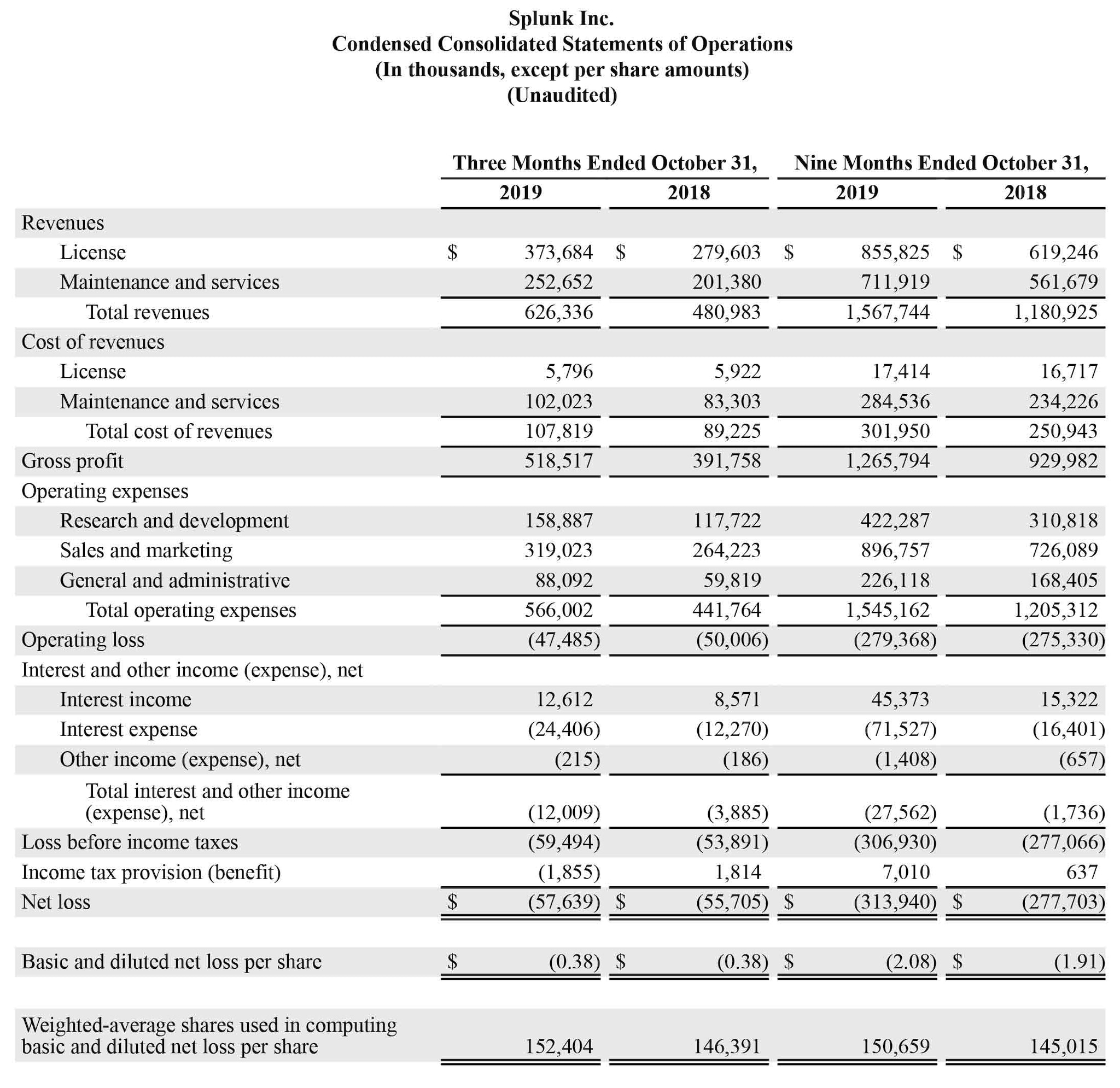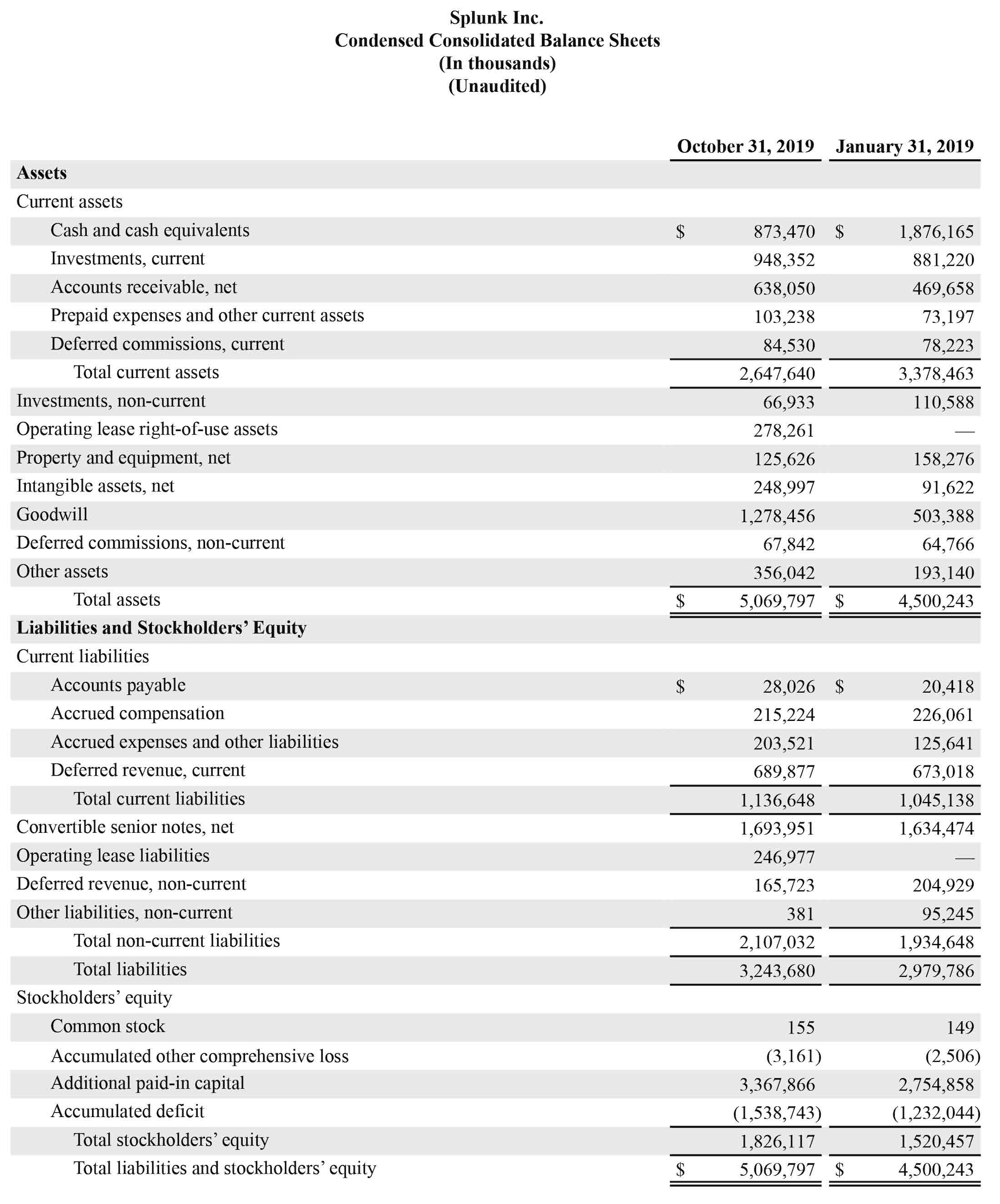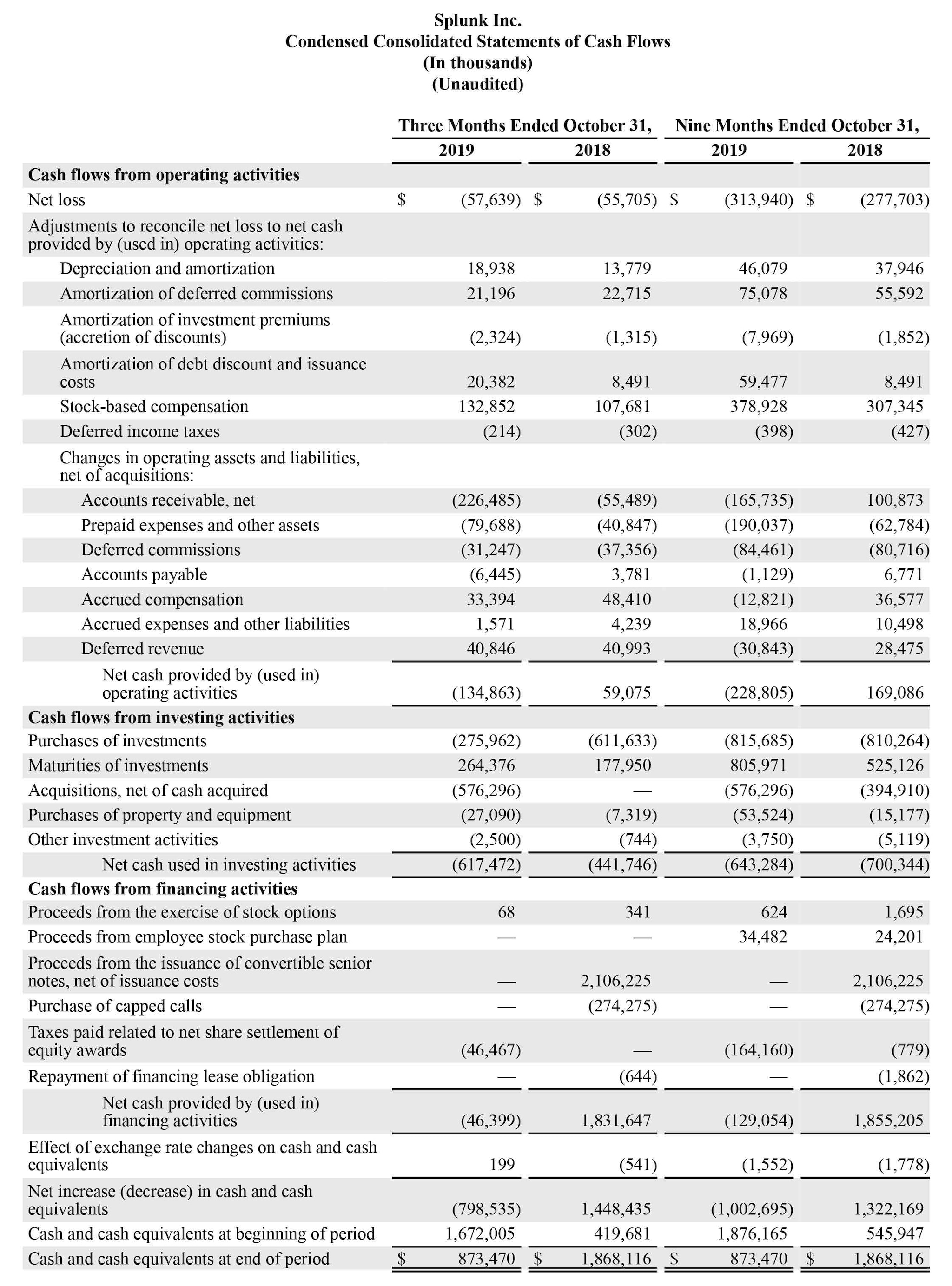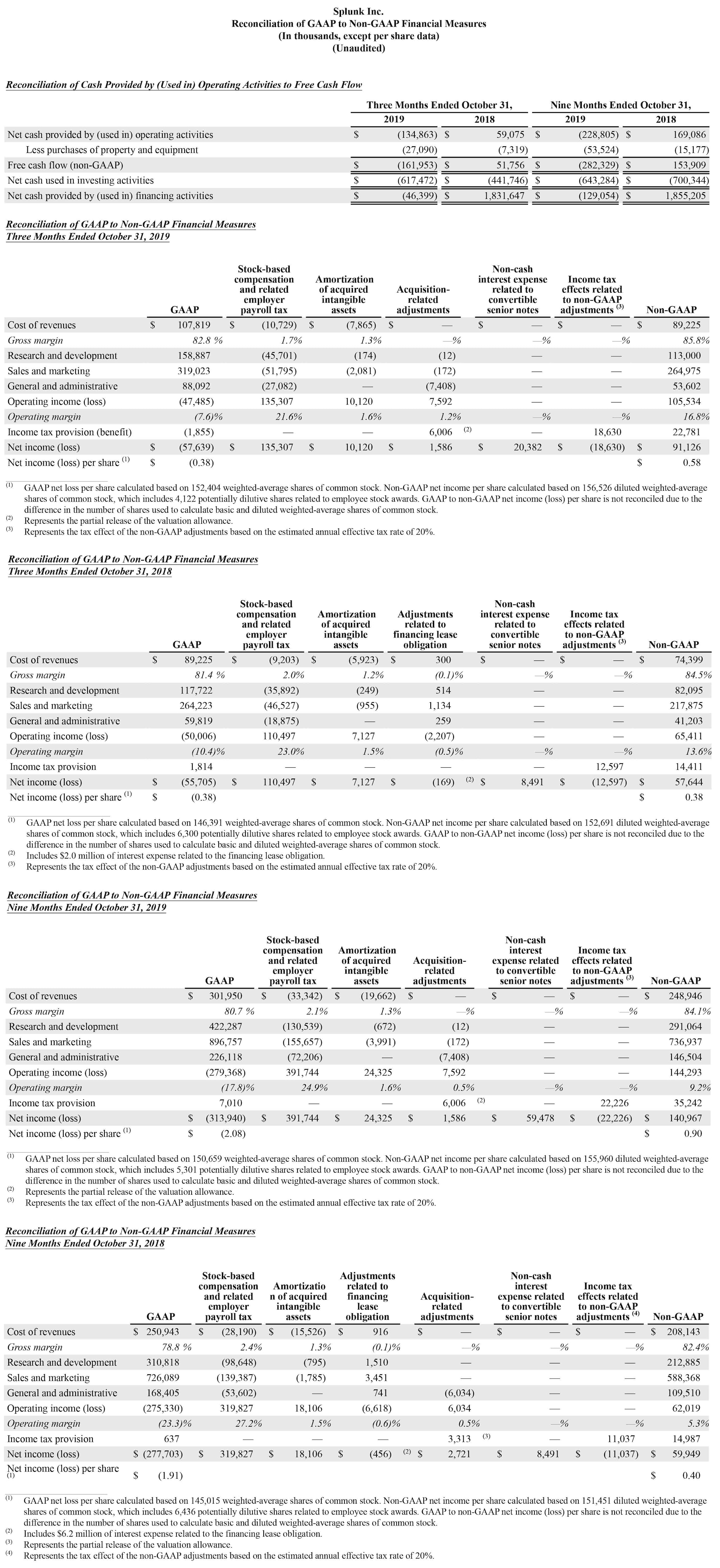SAN FRANCISCO – November 21, 2019 – Splunk Inc. (NASDAQ: SPLK), provider of the Data-to-Everything Platform, today announced results for its fiscal third quarter ended October 31, 2019.
Third Quarter 2020 Financial Highlights
- Software revenues were $454 million, up 40% year-over-year.
- Total revenues were $626 million, up 30% year-over-year.
- GAAP operating loss was $47 million; GAAP operating margin was negative 7.6%.
- Non-GAAP operating income was $106 million; non-GAAP operating margin was 16.8%.
- GAAP loss per share was $0.38; non-GAAP income per share was $0.58.
- Operating cash flow was negative $135 million with free cash flow of negative $162 million.
“Splunk continues to show the world how our Data-to-Everything Platform is uniquely positioned to bring data to every question, decision and action,” said Doug Merritt, President and CEO, Splunk. “Whether through our groundbreaking innovations like Splunk® Data Fabric Search and Splunk® Data Stream Processor or aggressive acquisition strategy, Splunk is transforming the way our customers around the world turn data into doing.”
“With the shift to a renewable model largely complete, momentum in our term license and cloud offerings drove 53% growth in total ARR during the quarter,” said Jason Child, chief financial officer, Splunk.
Business Highlights
Customers:
- Signed 440 new enterprise customers.
- New and Expansion Customers Include: Airbus Defence and Space (Germany), Anaplan, Bendigo Bank (Australia), Carnival Cruise Lines, Chegg, Crowdstrike, Lloyds Banking Group (United Kingdom), Monash University (Australia), NEC (Japan), SKY Italia (Italy), Takeda Pharmaceuticals (Japan), University of Adelaide (Australia), University of Bristol (United Kingdom), U.S. Census Bureau, Xcel Energy
Corporate:
- Splunk Unveils the Data-to-Everything Platform: At a special customer event featuring President Barack Obama, Splunk introduced the Data-to-Everything Platform, designed to unlock trapped value by bringing data to every question, decision, and action. The Splunk Data-to-Everything Platform helps customers around the world remove the barriers between data and action, allowing them to know what is happening within their organizations and turn data into doing.
- Product Innovations at .conf19 Help Customers Transform with Data: In front of a capacity crowd of 11,000 at .conf19, Splunk unveiled milestone updates to its Data-to-Everything Platform, including new products such as Splunk Data Fabric Search (DFS), which accelerates insights by integrating massive datasets; Splunk Data Stream Processor (DSP), which continuously collects high-velocity, high-volume data from diverse sources and turns it into valuable insights; and Splunk Mission Control, which combines the power of SIEM, SOAR and UBA into a common work surface that unifies security operations. Splunk also announced new versions of Splunk Enterprise 8.0 and Splunk Enterprise Security 5.0, designed to process massive scale to data in any form.
- Strategic Acquisitions Position Splunk as a Leader in Monitoring and Observability: In addition to its SignalFx acquisition, Splunk continues to make strategic investments that will help customers monitor and observe data no matter where they are in their cloud journey. Splunk also announced the acquisition of Omnition, a stealth-mode SaaS company that is innovating in distributed tracing, improving monitoring across microservices applications, and Streamlio, an open source distributed messaging leader that will help accelerate Splunk’s real-time stream processing.
- Splunk Ventures Invests in the Modern Data Ecosystem: Splunk announced the launch of Splunk Ventures, a $150 million fund designed to fuel the next generation of data analytics. Splunk Ventures’ Innovation Fund expects to invest $100 million in startups working to transform data into business value, and Splunk Ventures’ Social Impact Fund expects to invest $50 million in organizations using data for the good of society. Splunk also announced its first Social Impact Fund investment in Zonehaven, a cloud-based analytics application designed to help communities use data to improve evacuations and reduce wildfire risk.
- Splunk Cloud Attains FedRAMP Authorization: Splunk’s footprint in the federal government continues to grow. Splunk announced it has received FedRAMP authorization at a moderate impact level. Achieving FedRAMP authorization from the General Services Administration (GSA) FedRAMP Program Management Office (PMO) brings the power of Splunk Cloud to agencies that are eager to remove the barrier between data and action and turn data into doing.
Financial Outlook
The company is providing the following guidance for its fiscal fourth quarter 2020 (ending January 31, 2020):
- Total revenues are expected to be approximately $780 million.
- Non-GAAP operating margin is expected to be approximately 23%.
The company is updating its previous guidance for its fiscal year 2020 (ending January 31, 2020):
- Total revenues are expected to be approximately $2.35 billion (was approximately $2.30 billion).
- Non-GAAP operating margin is expected to be approximately 14% (unchanged from previous guidance).
All forward-looking non-GAAP financial measures contained in this section “Financial Outlook” exclude estimates for stock-based compensation and related employer payroll tax, acquisition-related adjustments, and amortization of acquired intangible assets.
A reconciliation of non-GAAP guidance measures to corresponding GAAP measures is not available on a forward-looking basis without unreasonable effort due to the uncertainty regarding, and the potential variability of, many of these costs and expenses that may be incurred in the future. The company has provided a reconciliation of GAAP to non-GAAP financial measures in the financial statement tables for its fiscal third quarter 2020 non-GAAP results included in this press release.
Conference Call and Webcast
Splunk’s executive management team will host a conference call today beginning at 1:30 p.m. PT (4:30 p.m. ET) to discuss the company’s financial results and business highlights. Interested parties may access the call by dialing (866) 501-1535. International parties may access the call by dialing (216) 672-5582. A live audio webcast of the conference call will be available through Splunk’s Investor Relations website at http://investors.splunk.com/events-presentations. A replay of the call will be available through November 28, 2019 by dialing (855) 859-2056 and referencing Conference ID 6965602.
Safe Harbor Statement
This press release contains forward-looking statements that involve risks and uncertainties, including statements regarding trends in revenue composition, statements regarding acquisitions and related benefits, Splunk’s revenue and non-GAAP operating margin targets for the company’s fiscal fourth quarter and fiscal years 2020 in the paragraphs under “Financial Outlook” above and other statements regarding our market opportunity, the market for data-related products, future growth, momentum, strategy, technology and product innovation, expectations for our industry and business, customer demand, customer success and feedback, expanding use of Splunk by customers, and expected benefits and scale of our products. There are a significant number of factors that could cause actual results to differ materially from statements made in this press release, including: risks associated with Splunk’s rapid growth, particularly outside of the United States; Splunk’s inability to realize value from its significant investments in its business, including product and service innovations and through acquisitions; Splunk’s shift from sales of perpetual licenses in favor of sales of term licenses and subscription agreements for our cloud services; Splunk’s transition to a multi-product software and services business; Splunk’s inability to successfully integrate acquired businesses and technologies; Splunk’s inability to service its debt obligations or other adverse effects related to our convertible notes; and general market, political, economic, business and competitive market conditions.
Additional information on potential factors that could affect Splunk’s financial results is included in the company’s Quarterly Report on Form 10-Q for the fiscal quarter ended July 31, 2019, which is on file with the U.S. Securities and Exchange Commission (“SEC”) and Splunk’s other filings with the SEC. Splunk does not assume any obligation to update the forward-looking statements provided to reflect events that occur or circumstances that exist after the date on which they were made.
About Splunk Inc.
Splunk Inc. (NASDAQ: SPLK) turns data into doing with the Data-to-Everything Platform. Splunk technology is designed to investigate, monitor, analyze and act on data at any scale.
Splunk, Splunk> and Turn Data Into Doing are trademarks and registered trademarks of Splunk Inc. in the United States and other countries. All other brand names, product names, or trademarks belong to their respective owners. © 2019 Splunk Inc. All rights reserved.



Splunk Inc.
Operating Metrics
Total Annual Recurring Revenue (“ARR”) represents the annualized revenue run-rate of active subscription, term license, and maintenance contracts at the end of a reporting period. Contracts are annualized by dividing the total contract value by the number of days in the contract term and then multiplying by 365.
Non-GAAP Financial Measures and Reconciliations
To supplement Splunk’s condensed consolidated financial statements, which are prepared and presented in accordance with generally accepted accounting principles in the United States (“GAAP”), Splunk provides investors with the following non-GAAP financial measures: cost of revenues, gross margin, research and development expense, sales and marketing expense, general and administrative expense, operating income (loss), operating margin, income tax provision (benefit), net income (loss), net income (loss) per share and free cash flow (collectively the “non-GAAP financial measures”). These non-GAAP financial measures exclude all or a combination of the following (as reflected in the following reconciliation tables): expenses related to stock-based compensation and related employer payroll tax, amortization of acquired intangible assets, adjustments related to a financing lease obligation, acquisition-related adjustments, including the partial release of the valuation allowance due to acquisitions, and non-cash interest expense related to convertible senior notes that were issued in the fiscal third quarter of 2019. The adjustments for the financing lease obligation are to reflect the expense Splunk would have recorded if its build-to-suit lease arrangement had been deemed an operating lease instead of a financing lease and is calculated as the net of actual ground lease expense, depreciation and interest expense over estimated straight-line rent expense. The non-GAAP financial measures are also adjusted for Splunk's estimated tax rate on non-GAAP income (loss). To determine the annual non-GAAP tax rate, Splunk evaluates a financial projection based on its non-GAAP results. The annual non-GAAP tax rate takes into account other factors including Splunk's current operating structure, its existing tax positions in various jurisdictions and key legislation in major jurisdictions where Splunk operates. The non-GAAP tax rate applied to the three and nine months ended October 31, 2019 was 20%. Splunk expects to utilize this annual non-GAAP tax rate for all of fiscal 2020 and will provide updates to this rate on an annual basis, or more frequently if material changes occur. The applicable fiscal 2019 tax rates are noted in the reconciliations. In addition, non-GAAP financial measures includes free cash flow, which represents cash from operations less purchases of property and equipment. The presentation of the non-GAAP financial measures is not intended to be considered in isolation or as a substitute for, or superior to, the financial information prepared and presented in accordance with GAAP. Splunk uses these non-GAAP financial measures for financial and operational decision-making purposes and as a means to evaluate period-to-period comparisons. Splunk believes that these non-GAAP financial measures provide useful information about Splunk’s operating results, enhance the overall understanding of past financial performance and future prospects and allow for greater transparency with respect to key metrics used by management in its financial and operational decision making. In addition, these non-GAAP financial measures facilitate comparisons to competitors’ operating results.
Splunk excludes stock-based compensation expense because it is non-cash in nature and excluding this expense provides meaningful supplemental information regarding Splunk’s operational performance and allows investors the ability to make more meaningful comparisons between Splunk’s operating results and those of other companies. Splunk excludes employer payroll tax expense related to employee stock plans in order for investors to see the full effect that excluding that stock-based compensation expense had on Splunk’s operating results. These expenses are tied to the exercise or vesting of underlying equity awards and the price of Splunk’s common stock at the time of vesting or exercise, which may vary from period to period independent of the operating performance of Splunk’s business. Splunk also excludes amortization of acquired intangible assets, adjustments related to a financing lease obligation, acquisition-related adjustments, including the partial release of the valuation allowance due to acquisitions, and non-cash interest expense related to convertible senior notes from the applicable non-GAAP financial measures because these expenses are considered by management to be outside of Splunk’s core operating results. Accordingly, Splunk believes that excluding these expenses provides investors and management with greater visibility to the underlying performance of its business operations, facilitates comparison of its results with other periods and may also facilitate comparison with the results of other companies in its industry. Splunk considers free cash flow to be a liquidity measure that provides useful information to management and investors about the amount of cash generated by the business that can be used for strategic opportunities, including investing in its business, making strategic acquisitions and strengthening its balance sheet
There are limitations in using non-GAAP financial measures because the non-GAAP financial measures are not prepared in accordance with GAAP, may be different from non-GAAP financial measures used by Splunk’s competitors and exclude expenses that may have a material impact upon Splunk’s reported financial results. Further, stock-based compensation expense has been and will continue to be for the foreseeable future a significant recurring expense in Splunk’s business and an important part of the compensation provided to Splunk’s employees. The non-GAAP financial measures are meant to supplement and be viewed in conjunction with GAAP financial measures.
The following tables reconcile Splunk’s GAAP results to Splunk’s non-GAAP results included in this press release.


